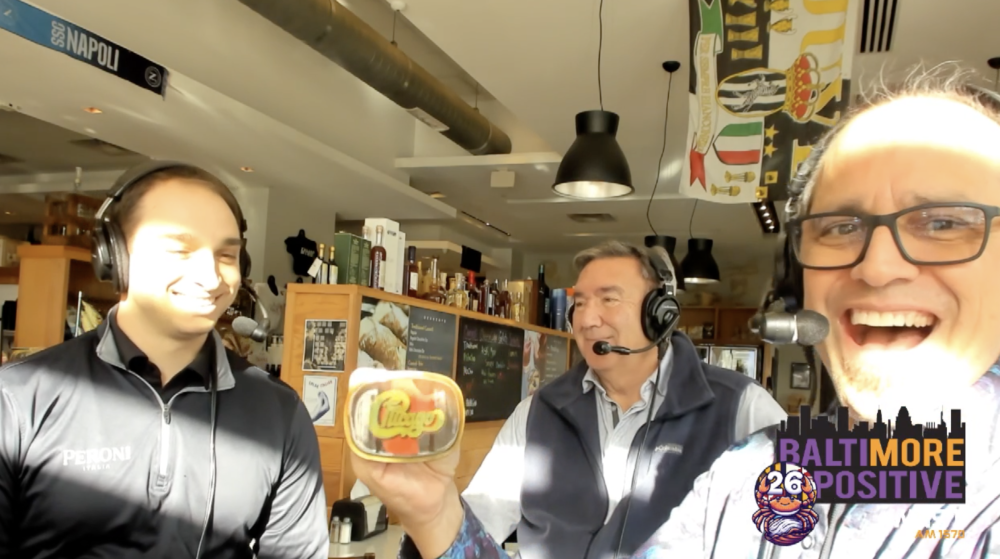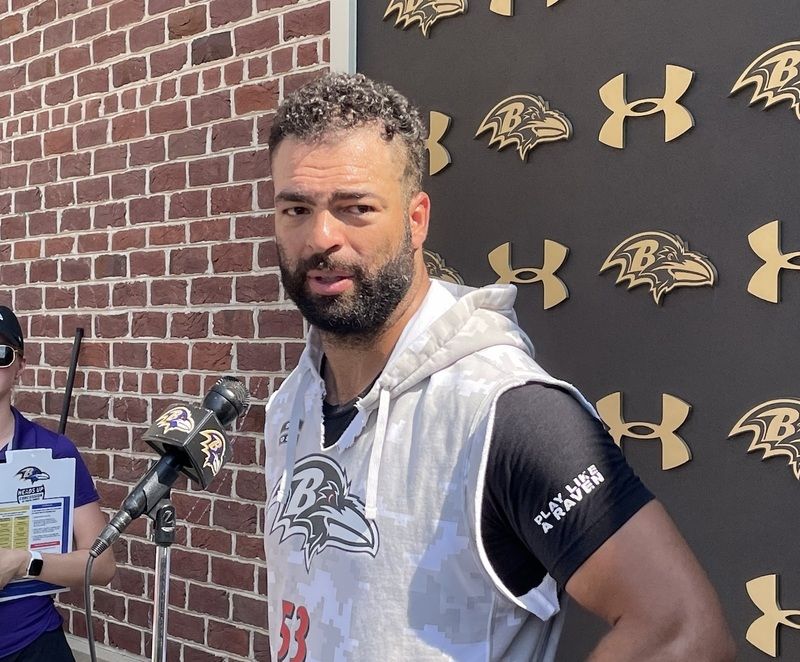OWINGS MILLS, Md. — Ravens head coach John Harbaugh noted his team had run the ball 25 times when the inevitable question came about the run-pass ratio from Sunday’s 12-9 loss at Cleveland.
Baltimore had also run a season-high 84 plays, but the 11th-year coach made his position clear on Monday.
“I don’t understand the question, why it’s a topic,” Harbaugh said. “You have to do whatever you have to do to move the ball and score points. We’ve been doing a pretty good job of that up until this last game. We just need to put more points on the board. Nine points — three, three, and three — is tough to win games that way. That’s the bottom line.
“But this run-pass balance thing, I don’t understand why it’s a topic.”
He’s right about both his offense — which ranked in the top 10 in multiple categories entering Week 5 — and the overall run-pass obsession many have when spitting out stats about win-loss records and running the ball a certain number of times that confuse correlation with causation. Simply put, teams run when they win, not win because they run. You sometimes wonder if some would prefer running the ball more — no matter how effectively — to their team actually winning games, but today’s NFL is a pass-heavy league and analytics-based principles such as throwing more frequently on first down improve your chances of winning compared to the traditional three yards and a cloud of dust. Like it or not, that mindset isn’t changing anytime soon.
The difference Sunday from previous weeks, however, was that the Ravens weren’t passing the ball effectively while they averaged a season-best 4.6 yards per carry, well ahead of what they’d done in the first four games. Joe Flacco produced 2018 worsts in both yards per attempt (5.3) and completion percentage (51.8 percent) on Sunday, but Baltimore continued to chuck it anyway with the veteran quarterback recording a season-high 56 attempts, territory in which few quarterbacks consistently function well. There were certainly occasions when offensive coordinator Marty Mornhinweg could have worked an additional run into the mix.
Passing on 11 of 14 plays inside the red zone was particularly questionable as Flacco threw an ugly interception on a second-and-goal play from the 2 in the second quarter that proved to be one of the most critical plays of the game. Harbaugh and the Ravens frequently view the goal line to be four-down territory — which is the correct mindset — so why not try to pound the ball into the end zone again after Buck Allen was stopped on the previous down?
It’s true that only six teams have more rushing attempts than the Ravens through Week 5, but they also lead the NFL in offensive plays run and only 10 teams have rushed less frequently than their 36.3 percent. When you match that with Baltimore winning all three of its games by double digits and trailing by multiple possessions in just one game (Cincinnati), you’re probably justified if you want to roll your eyes the next time you hear Mornhinweg say they want to run the ball. The Ravens are currently a passing team, and that had worked very well until Sunday.
The warranted criticism from Week 5 aside, the problem with the Ravens running game has been quality much more so than quantity. Clamoring for more rushes doesn’t exactly make a ton of sense when you rank 30th in the league in yards per carry (3.4). That’s not to say the ground game doesn’t need to improve with Sunday’s poor passing performance being a perfect example why.
“Yes, we’re concerned. We want to run the ball well,” Harbaugh said. “We’re working as hard as we can to do it. If the question is: Are you working hard at the run game? Yes, we’re working really hard at it. We want to be a really good running team just like we want to be a great passing team and great at everything else. We work hard at what we think we can do well.”
After adding three veteran wide receivers and drafting two tight ends, the Ravens passing more frequently than they did last year when they ran 43.6 percent of the time — 12th most in the NFL — seemed inevitable, but why has the running game struggled so much?
Assistant head coach Greg Roman and offensive line coach Joe D’Alessandris were viewed as miracle workers last year when the Ravens averaged 4.0 yards per carry and finished 11th in rushing yards per game despite having four new starters along the offensive line. Even with the departures of center Ryan Jensen and right tackle Austin Howard, the healthy returns of guards Marshal Yanda and Alex Lewis brought optimism that the unit would improve from a year ago.
The group has held up well in pass protection, but Lewis, center Matt Skura, and right tackle James Hurst have graded particularly poorly in run blocking, according to Pro Football Focus. As was the case on Sunday when Alex Collins ripped off a 19-yard run on the first play from scrimmage and Allen picked up 17 yards on a third-quarter run, most of their rushing success has come on the outside, which makes sense when two of your three interior linemen have been below-average run blockers.
It’s also worth noting the Ravens have been in the shotgun much more frequently this season — 63 percent compared to 48 percent last year, according to Sharp Football — which certainly impacts the dynamics of a ground attack. That’s not to say an offense can’t run effectively from the shotgun, but it’s a more passing-minded formation and the Ravens are also running a little less frequently out of the gun than they did last year (18 percent compared to 22 percent, per Sharp).
Only one of the five opponents Baltimore has faced this season is allowing fewer than 4.1 yards per carry and only Cleveland ranks in the top 10 in Football Outsiders’ run defense efficiency metric. In other words, the Ravens haven’t exactly been running against the 2000 version of themselves in the season’s first month.
Surely concerns over Collins fumbling the ball haven’t helped, but he leads all running backs in forced missed tackles per touch, which reflects a lack of running room and a need to keep giving him opportunities to break longer runs. Allen is a capable short-yardage back and better in the passing game, but his 2.8 yards per carry average compared to Collins’ 3.8 reflects less explosiveness. Neither back has the dynamic talent of a Ray Rice, but the pair did the job for the Ravens last year, making it difficult not to look at an offensive line still trying to find its footing in the running game.
Perhaps Sunday’s defeat serves as both a necessary reminder that you can’t do it all with the pass and a sign of better things to come for the ground attack, but the week-to-week volatility of the NFL makes it difficult to predict.
“You just keep working. You keep grinding,” Harbaugh said. “When we come out and run for 200 yards — which we will — it’s not going to be ‘fixed.’ The next game is going to be a new game. It’s not like you’re going to come out and run for 200 yards every week. Every week is a new week in the National Football League. You see a different defense, you see different fronts, different guys are healthy, different guys aren’t healthy, plays get made, plays don’t get made — things happen.
“I don’t think it’s as much of a trend as everybody wants to look at it. The big-picture trends just really aren’t there.”
Maybe so, but it’s difficult envisioning the Ravens getting to where they want to be by season’s end without having a better running game in their back pocket when they need it.
Lack of quality plaguing Ravens running game more than quantity

Luke Jones
Luke Jones is the Ravens and Orioles beat reporter for WNST BaltimorePositive.com and is a PFWA member. His mind is consumed with useless sports knowledge, pro wrestling promos, and movie quotes, but he often forgets where he put his phone. Luke's favorite sports memories include being one of the thousands of kids who waited for Cal Ripken's autograph after Orioles games in the summer of 1995, attending the Super Bowl XXXV victory parade with his dad in the pouring rain, and watching the Terps advance to the Final Four at the Carrier Dome in 2002. Follow him on social media @BaltimoreLuke or email him at Luke@wnst.net.
Podcast Audio Vault
Share the Post:
Right Now in Baltimore
Coloring our holiday world with an Italian feast at Di Pasquale's
Reaching back to his Italian heritage in East Baltimore, Nestor returns to DiPasquale's in Canton to learn about the Feast Of The Seven Fishes and some Highlandtown holiday magic with legendary UMBC soccer coach Pete Caringi and friends of the family.
Twelve Ravens Thoughts following Week 15 win at Cincinnati
Luke Jones offers his latest purple musings after Baltimore's first shutout since 2018.
Izzy running for Baltimore County Executive? Yes, and here's why...
The return of 2nd District Councilman Izzy Patoka to the Maryland Crab Cake Tour at Honey's in Halethorpe provided Nestor a clear view of his key campaign issues and goals in a spring run as a Democratic candidate to be the next Baltimore County Executive.

























